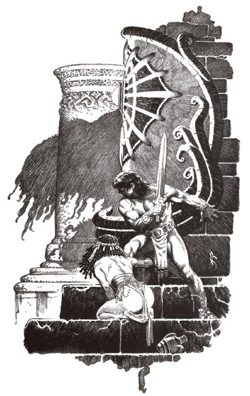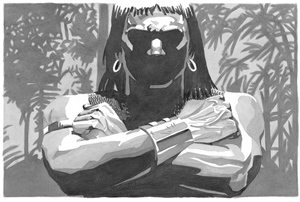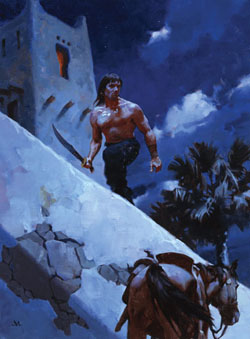Earlier, on Tor.com, Douglas Cohen’s post “The Hidden Burden of an Icon: Robert E. Howard’s Conan the Barbarian” explored the popular perception of Howard’s work versus his actual writing. I have often wondered how difficult it must be for an artist to tackle a character so defined by Frank Frazetta‘s visceral barbarian and Arnold Schwarzenegger’s monosyllabic warrior. Wandering Star and Del Rey have been publishing lavishly illustrated editions of Howard’s work over a number of years, and I asked four of the artists recently associated with the Cimmerian how they were able to make the character their own considering the weight of it’s visual history.
 Mark Schultz
Mark Schultz
Conan has achieved a sort of iconic status which unfortunately carries with it a gross simplification of the complexities of the character as originally written by his creator, the massively talented Robert E. Howard.
Howard created Conan, and the genre that later came to be called “sword and sorcery,” not simply as venues for bloody action, but as expressions of his views on life, history, and society. That he could disguise his philosophical musings within rousing good adventure and compelling character was but one aspect of his talent.
The one-note depiction of Conan as snarling, mindless killing machine has become short-hand for the character and, unfortunately, the only aspect recognized by the wider public. It’s a powerful, dramatic aspect in a commercial sense—and one too easily returned to by illustrators aping their predecessors—but does a disservice to the richness of the character as written by Howard.
I’ve tried in my depictions of Conan to always refer back to the descriptions of his creator. Howard wrote him as a triumph of pure merit over established societal mores. Conan has a genius for rising above his circumstances and improving his situation: he comes from Cimmerian poverty to become king of the greatest nation of his time, and that doesn’t happen merely because he is the most physically imposing warrior. Howard depicts him with plenty of smarts, curiosity, empathy, adaptability, self-depreciation, charisma–in short, all the factors needed to make a superior leader. He grows and changes throughout Howard’s stories. I’m always attempting to keep that in mind as I draw Conan.
Conan fans who haven’t read Howard’s work should absolutely treat themselves and sit down with the man who created the genre!
When I started the five stories that comprise The Conquering Sword of Conan, I was under the impression that Conan was a knucklehead, but quickly became impressed with Howard’s wordsmithing and ultimately came away enjoying a less touted aspect of Conan: his stealthy intelligence. This was my angle. Trying to illustrate a book on Conan against such preconceived ideas was troublesome.
Frazetta buried that barbarian image so deeply, he managed to accomplish two things: he viscerally allowed Conan to explode onto our imagination, and destroyed any further interest in learning his subtler sides. That’s why the quiet brooding side of Conan appealed to me, and I tried to bring that out. I made him more lithe and panther-like, just as Howard mentions, and this made the difference.
I tried to look beyond Conan’s racist and misogynistic attitudes, and considered when and where the man was writing. Sadly, Conan is not the perfect hero, but fun to debate. And this will ensure that he’ll be ‘captured’ over and over again. No one person will nail him completely.
 Jim and Ruth Keegan
Jim and Ruth Keegan
As illustrators of Del Rey’s Best of Robert E. Howard set, we had a lot of characters to tackle, but none of them came with more baggage, artistically speaking, than Conan. It would be difficult to find a character that has been more thoroughly illustrated—and by some of the best artists that have ever worked in the business. Thanks largely to Frank Frazetta, Conan has a certain visual image that needs to be acknowledged; the way an artist illustrating Sherlock Holmes would find it difficult to ignore the work of Sidney Paget.
So, we tried to keep the basic, established “look” of Conan, but took a graphic approach that we hadn’t seen done before with this character. Fantasy art can often be very fetishistic, with lots of highly rendered detail and decoration. So, we went in the opposite direction; large, simple masses and lots of shadow. An appropriate approach, we felt, for such an unapologetically masculine character.
Unlike a cover illustration, our black and white interior pictures had to be designed to sit side-by-side with the body of Howard’s text, so we also tried to create illustrations that were faithful to the text, but didn’t nail everything down—allowing REH and his powerful prose to do what they did best, without interference from us.
![]() Gary Gianni
Gary Gianni
The illustrator’s fascination with Howard’s characters is largely due to the room the author allows us to imagine personal heroic proportions. Howard writes with a sweeping overview of his characters and the results are these mythic archetypes. Beginning with Ulysses and Beowulf and right up through Batman and Superman, readers interpret fictional characters to fit a sense of their own ideals. Who’s to say which image is accurate? If nothing else, it’s a credit to R. E. Howard that his writings remain vibrant and spark such lively debates!











